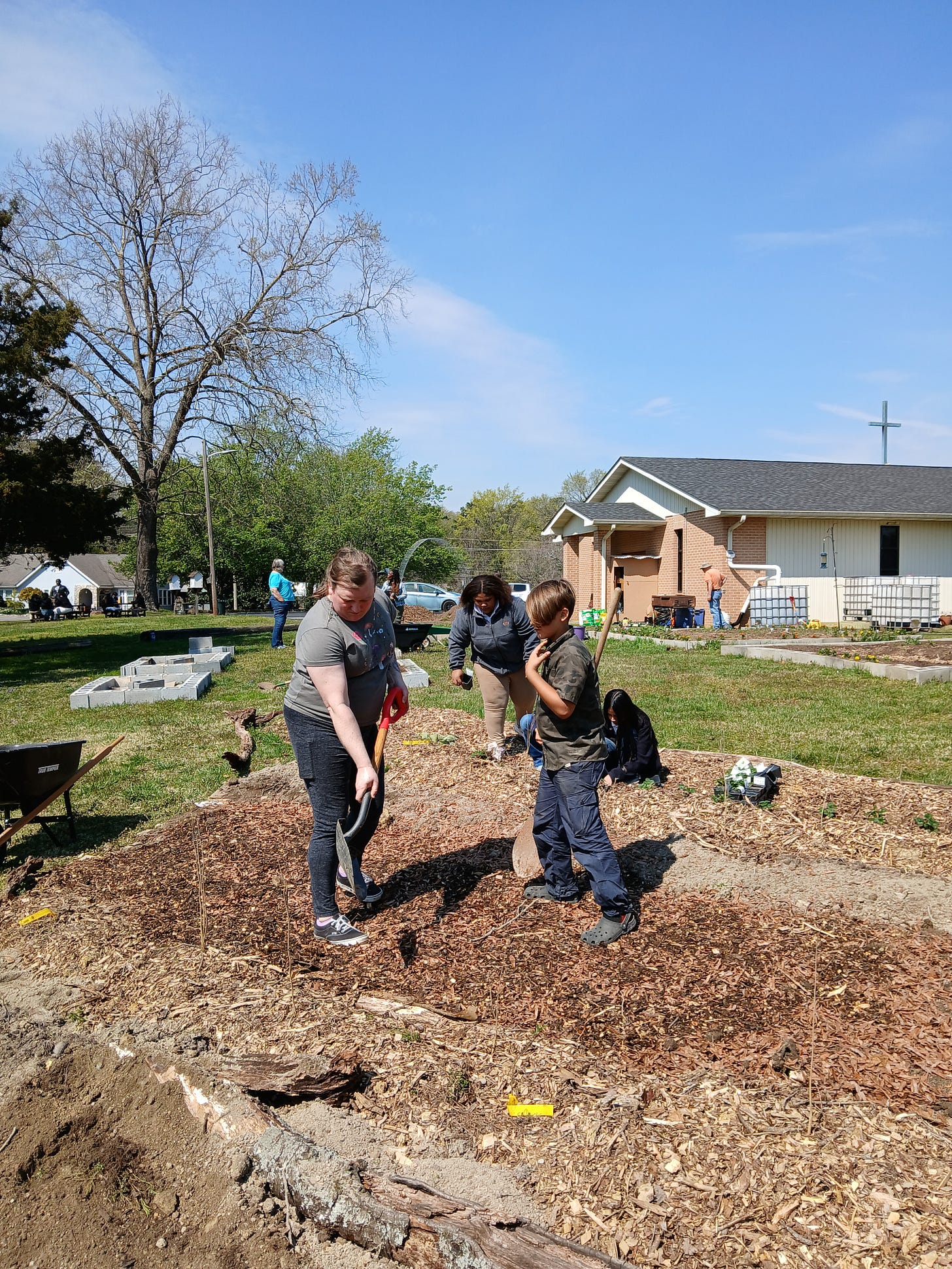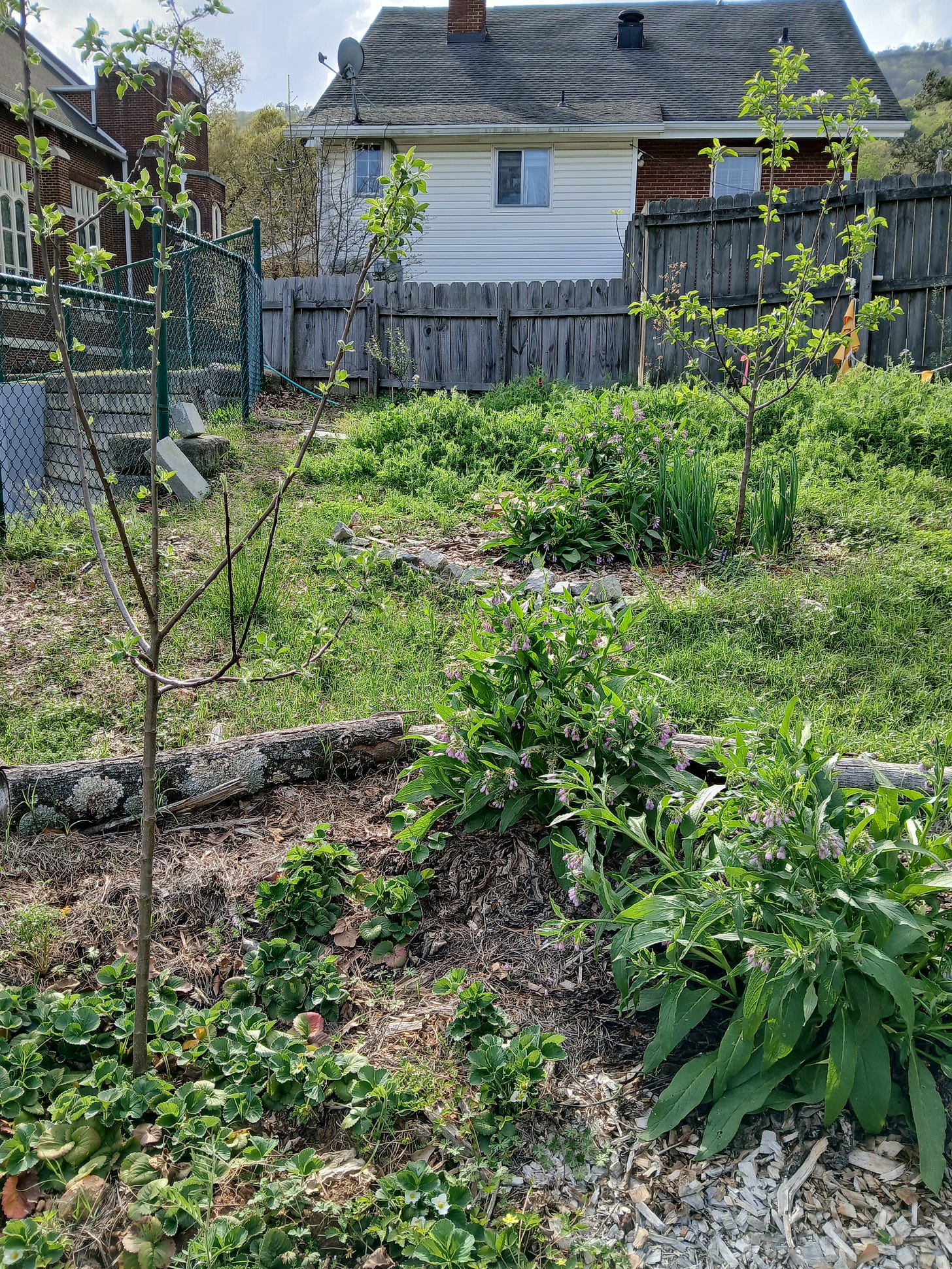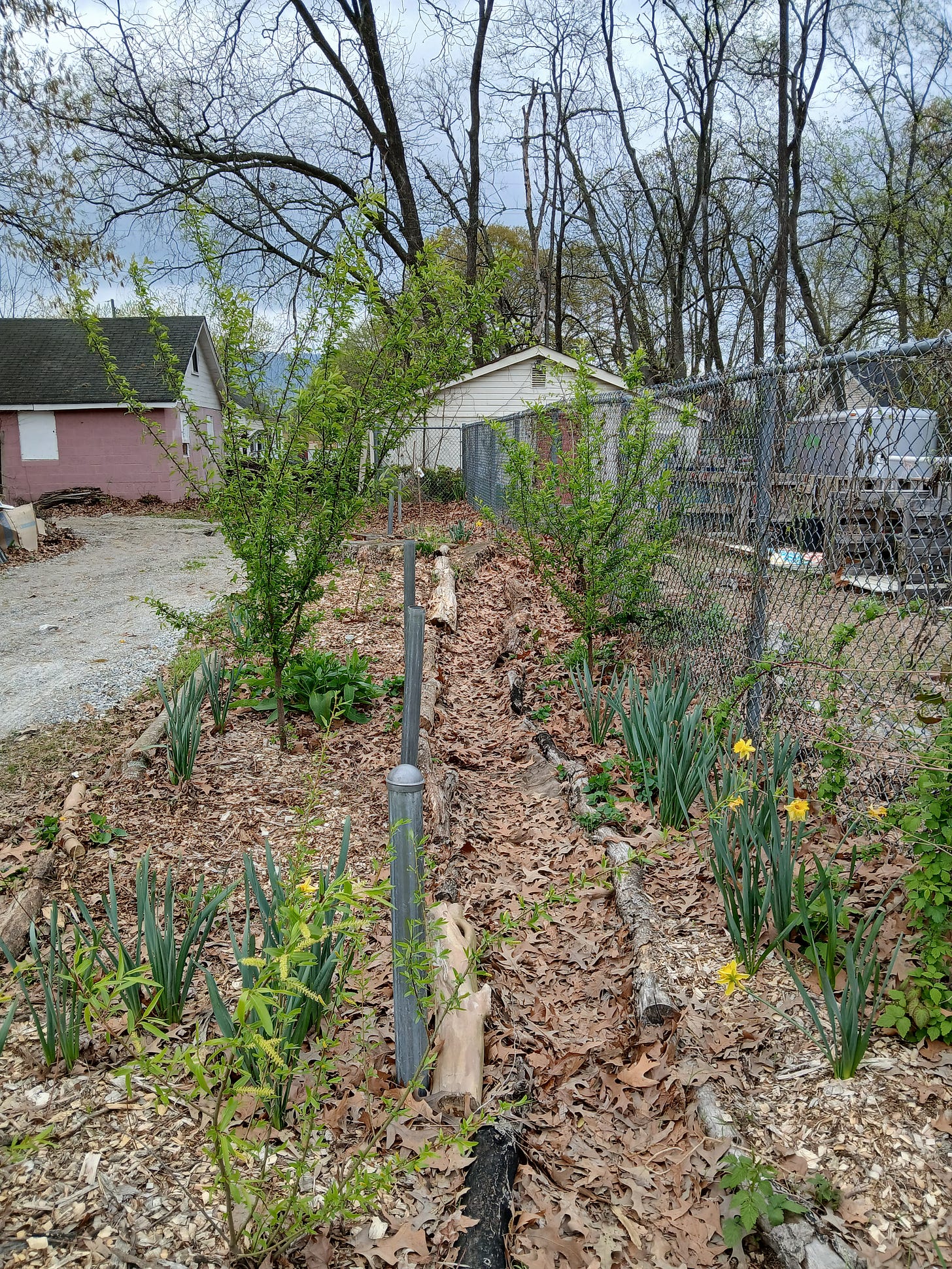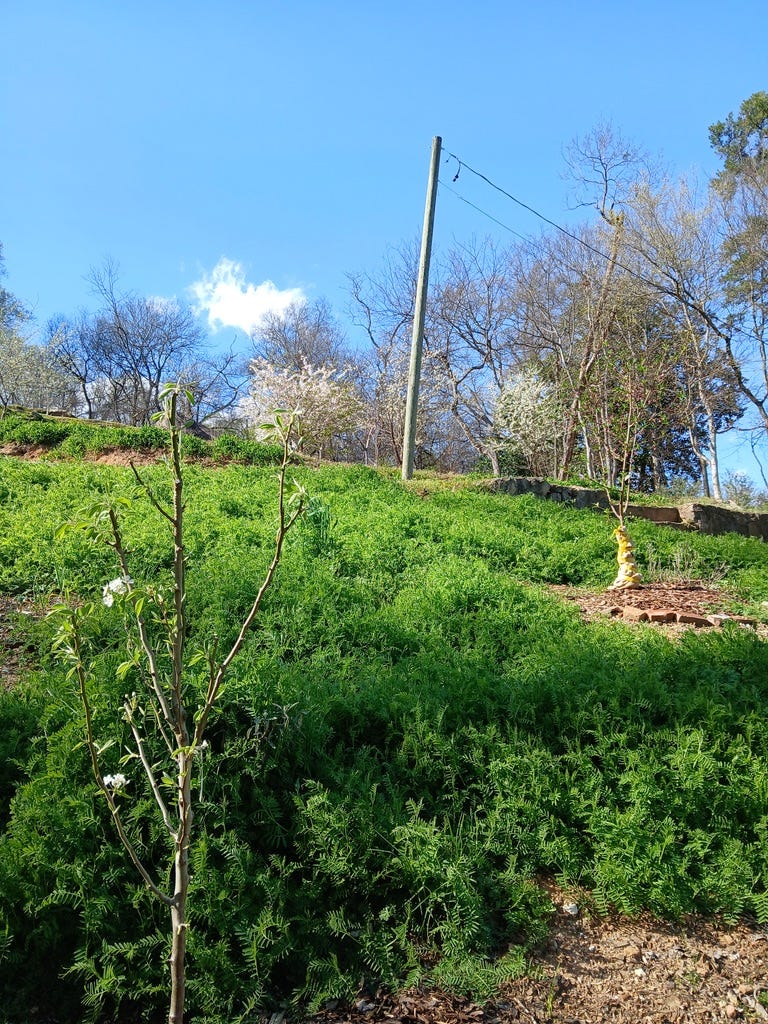It’s been a tumultuous few months here in the United States, and there are plenty of reasons to look around at the general trajectory of our country and the wider world and feel less than optimistic, let’s just say. Fortunately the cycle of seasons continues, winter giving way to spring, even as over the last couple of weeks we have swung wildly between out and out summer and back to late winter. While it is no longer the case that human affairs have no effect on the way the seasons unfold, they do still unfold, the trees and understories leafing and blooming and gardeners scrambling to keep up; the dates and pace of things might be scrambled increasingly from year to year, but they still happen, and that is a recurring locus of hope and encouragement I think.
It’s also been a very busy couple of months for Chattanooga’s community food forests and gardens, with hundreds—yes, hundreds!—of new trees of all sorts having been planted, mostly in March, reaching a rather frantic pace given that bare-root trees, which accounts for virtually every tree we’ve planted this year so far, having a fairly limited window from time of delivery to the time they need to be in the ground, not to mention the fact that once warmer weather arrives and stays tree planting becomes much more difficult (well, not so much the planting as the keeping them alive after planting!), though not quite impossible.
Instead of a full report from the month, which would be longer than probably anyone would want to read, let me give you an idea of just one week in March, and at that just the work in which I was directly involved; I’ve copied and pasted the following from my own work log, for the week of March 16:
Ascension Lutheran Church, East Ridge: Over the course of three work days we added a food forest component to the existing community garden managed by Hope Community Fridge, while also expanding the community garden with materials salvaged from the Neema garden on Main Street. We built four berms and swales by hand, piled on woodchips sourced from Emma Wheeler, and planted in approximately 80 mostly small trees, with the goal of adding ground cover perennials in the near future. The two Sunday afternoon work days were very well attended, with about twenty volunteers at the first one (which was also focused on getting the community garden going) and around fifteen at the second; in between the two workdays the students and teachers from Reconnect Nature School spent a Thursday morning working on the project, for a total of around fifty volunteers contributing to the process. Continuing stewardship will be divided among community garden participants, church members, Hope Community Fridge, and Reconnect, with the Food Forest Coalition continuing to lend occasional support and guidance.
Ella Library: On Monday of this week I brought over plant starts–lettuce, arugula, collars, and mustard–from the Gateway Greenhouse, which the kids planted out and watered; we also added a few more trees to part of the garden and moved some perennials plants out of the raised wooden beds into the ground. Seven to eight kids and three adults participated in the planting (my own children unfortunately were sick that day and did not participate). The week prior I met with the representative from the county who oversees the teaching garden grant process, and will be sending him a list of materials to be purchased and added to the garden there.
Emma Wheeler: Today we began cleaning out and planting into the community garden beds there, which will continue this afternoon, full report for next week.
Death Farm, Chickamauga: Last Saturday I and others assisted Taylor in planting out several hundred trees supplied by Contour Lines into the berms and swales on his property previously built for said purpose. At my home property I temporarily planted most of the remaining trees supplied by Contour Lines which we were unable to plant at Emma Wheeler at present [due to some bureaucratic issues that needed more resolving than we had originally assumed!].
St. Elmo: On Tuesday of this week we hosted the international delegation from the National Park City Foundation, with Denise the site steward giving a talk and leading participants on a tour of the site. [Not long after this visit Chattanooga was awarded National Park City official status!] The week prior she oversaw extensive infrastructural work at the site, including adding a really lovely stick and branch fence along the property line; she also demarcated a new space that will be the preserve of Master Gardeners she is recruiting to work in and use the space in the near future. Her Cub Scout troop planted greens, sourced from Gateway, on Sunday afternoon.
Chattanooga Valley Church of the Nazarene, Flintstone: We met with several people on the community agriculture team there on Wednesday evening to plot out things for the upcoming work day on Sunday afternoon, determining roughly were annual vegetable beds are going to go and a general idea of the initial stage of the food forest installation; both will be using currently barren dirt resulting from the take-down and distribution of dirt piles left over from the church’s construction years ago. We also moved and continued work on the compost bin at the site.
While a lot has been going on at every site, the two that have expanded the most rapidly this past month are Ascension Lutheran and Chattanooga Valley Church of the Nazarene; the former had a community garden established last year but much expanded the last month, to which we have now added a food forest, while the latter is an entirely new project. And we have had more inquiries about additional new sites, or places that have previously had some form of community agriculture and want to revive things; we are at a point where taking on new projects will really require expanding our resource base, both in terms of highly dedicated week on week volunters and, Lord willing, some kind of more or less sustainable income stream. We know that it’s about as bad a time as ever in our lifetimes at least to be trying to support an agricultural and ecologically focused non-profit organization, so any suggestions, gifts, and so forth would be more than appreciated should you have them to give!
As for how things are growing, well, let me just regale you with a few pictures taken over the last couple weeks, at, in order, St. Elmo United Methodist Church, Lookout Mountain Conservancy’s Rockmont Park, and the Ella Library:
All of these sites, like pretty much everywhere we are working, were, until quite recently, just grass, and in some cases barely that. I know I harp on it a lot but it’s just incredible how much collectively we have been able to accomplish in getting these spaces back to life, producing for humans and encouraging the flourishing of many, many other forms of life. It’s just beautiful y’all.
Let me wrap up this month’s (much more belated than I had intended) issue with two more images that I hope capture the sense of promise, even in the proverbial ruins, that we are striving to realize, to hold back against the dooming tendency that is all too easy (ask me how I know!) to fall into these days.
The first is a tiny fig start, which the kids at the Ella Library helped plant during our Tennessee Tree Day activities the last weekend of March. There was much excitement over this little fig and the second one we put in, both of them grown from cuttings of a tree at the Gateway (Westside) Community Garden and Greenhouse; I tempered it a bit by telling them I honestly wasn’t sure if it would make it. Well, so far, it has!
The second image is of a little garden we put together at Ascension, using materials salvaged from the Neema Community Garden on Main Street, a garden which, as I imagine some of our readers will be aware, is slated for destruction now that the lot in which it sits has been marked for development. There are a lot of materials and plants still in the garden, however, accumulated over many years of use and growth. We’ve been trying to recover and move as much as possible, from concrete blocks to soil to plants; this little garden is the result of such salvaging work, a mix of cactus, irises, and kale, ringed by stones that formerly made up a keyhole garden. It’s rather bittersweet, like many acts of recovery and backstopping, which is often what we must do—ideally we could have found a way to keep the Neema Garden going, but that is almost certainly not going to happen. That we can keep parts of it alive elsewhere is at least still a small victory.










Doing the good work.